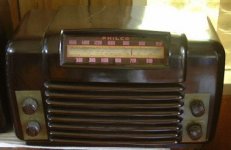bettablue
Veteran Member
I remember, back in the late 1970's to early 80's, I had an old Philco tube radio. I loved that thing, and kept it in my work room where I would turn it on for background noise, and to listen to some tunes and general news. That radio, like most tube audio systems sounded great, especially compared to a transistor radio with the same basic size, and speaker. Like most tube amplifiers, compared to more modern transistor, which often sounded cheap and tinny, the Philco sounded rich, and seemed to have a much more pleasing sound. Not only did the old radio give off a "presence" with its sound quality, but the Bakelite cabinet gave the radio a real sense of quality; a quality that you just don't see now days! 8-)
Why bring that up here? Well, I was going through some old boxes at my folks home not long ago, I came across the Philco. Sadly, somewhere between then and now, the radio became nonfunctional.
I was able to find some replacement tubes, and broke out my old Simpson Multimeter to start diagnosing the problem. I found a few loose connections, and there were a couple of wire splices that needed replacing, but overall, nothing was obviously "wrong". The fuses I bought were tested in another radio at a vintage electronics repair shop where they offer free tube testing. I had all 5 of the tubes tested before I bought them, so I know they're OK. I also tested the power supply's capacitor and coil, and the speaker. Unfortunately, none of my testing provided any answers, and the lady is still DOA.
Here's where I am right now. The tube heats up and gives off a very low but pleasant glow. Somewhere along the way, I must have done something right because the light behind the faceplate suddenly began working when I turned the radio on after my testing. The funny thing is that the light never worked before! Still though, nothing comes out of the speaker.
I can't bring myself to let the old lady go to the recycler, or worse yet, the trash! Oh, Hell No!!! The shop where I bought the fuses offered to buy my old Philco and even refund the money I paid for the fuses, so I know there's something with the old lady that's worth some money. But I'm not looking for the money (as much as I could use it.) I want my old friend to sound-off once more. I want to feel the knob "Click" as I turn on the power
Waiting 20 to 30 seconds as it warms the tubes in preparation for the days' work was the norm back when I had the radio in my work area as a young man. Sort of the same thing as I boot up my trusty 5150... (sighs) Oh the memories of an older man.
Until I find an exact replacement to put in my hobby/work room, I'll keep her around and try a few more tricks. So, does anyone have any ideas as to where to look next in my diagnostics? :confused2:
If I can't fix the old girl, I guess I'm in the market for another Philco tube radio. Who knows, I may even find one on E-Bay... :rastarolleye:
Why bring that up here? Well, I was going through some old boxes at my folks home not long ago, I came across the Philco. Sadly, somewhere between then and now, the radio became nonfunctional.
I was able to find some replacement tubes, and broke out my old Simpson Multimeter to start diagnosing the problem. I found a few loose connections, and there were a couple of wire splices that needed replacing, but overall, nothing was obviously "wrong". The fuses I bought were tested in another radio at a vintage electronics repair shop where they offer free tube testing. I had all 5 of the tubes tested before I bought them, so I know they're OK. I also tested the power supply's capacitor and coil, and the speaker. Unfortunately, none of my testing provided any answers, and the lady is still DOA.
Here's where I am right now. The tube heats up and gives off a very low but pleasant glow. Somewhere along the way, I must have done something right because the light behind the faceplate suddenly began working when I turned the radio on after my testing. The funny thing is that the light never worked before! Still though, nothing comes out of the speaker.
I can't bring myself to let the old lady go to the recycler, or worse yet, the trash! Oh, Hell No!!! The shop where I bought the fuses offered to buy my old Philco and even refund the money I paid for the fuses, so I know there's something with the old lady that's worth some money. But I'm not looking for the money (as much as I could use it.) I want my old friend to sound-off once more. I want to feel the knob "Click" as I turn on the power
Waiting 20 to 30 seconds as it warms the tubes in preparation for the days' work was the norm back when I had the radio in my work area as a young man. Sort of the same thing as I boot up my trusty 5150... (sighs) Oh the memories of an older man.
Until I find an exact replacement to put in my hobby/work room, I'll keep her around and try a few more tricks. So, does anyone have any ideas as to where to look next in my diagnostics? :confused2:
If I can't fix the old girl, I guess I'm in the market for another Philco tube radio. Who knows, I may even find one on E-Bay... :rastarolleye:

